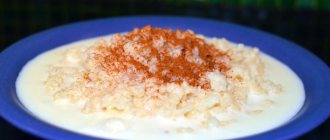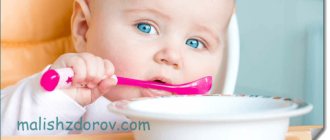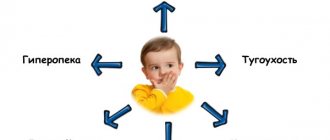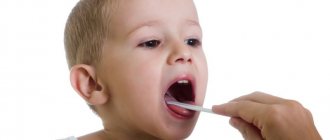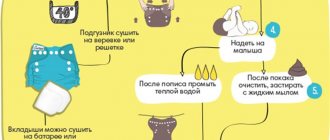Have you met people who don't like the taste of fried food? Me not. It is very difficult to resist deliciously smelling, golden-crusted dishes that have just been smoking in a frying pan.
Did you know that we ourselves instill food habits in our children? Moreover, not only with the introduction of complementary foods, but also by your own example.
So, a large number of parents ask the questions: “Can a child eat fried food?”, “At what age can a child eat fried food?” and “What are the harms of fried foods?” Let's look for answers to them together.
Can children eat fried food?
Fried foods are bad for children. Everyone knows about this. But some caring mothers, focusing on their taste sensations, treat their kids and add fried food to the soup. Justifying himself by the fact that otherwise the baby will not want to eat these dishes. But is it? Of course not. Once again I would like to remind you that we ourselves create the taste preferences of children.
Why can't children eat fried food? What is the harm of fried food?
Are you familiar with the feeling of heaviness in the stomach, indigestion, or heartburn after a delicious fried dish? I think yes. So, all the dangers that lurk in a portion of fried food increase significantly for a child. It does not have the toxin defense system that an adult does.
If you think that the harm of fried food for children is “not that great,” be sure to read our arguments:
1. Increasing the calorie content of foods
while frying.
The frying process is accompanied by the use of a large amount of oil, and it increases the calorie content of any dish. About 2 g of fat (18 kcal) is added to each 100-gram serving of food when fried.
2. High fat content of dishes interferes with the normal functioning of the stomach, intestines, and liver
.
Fatty fried foods are heavy; they undermine the health of children and adults. It slows down the digestion process, reduces the motor activity of the smooth muscles of the intestines, disrupts the coordinated functioning of the entire body, and leads to rapid weight gain.
3. During frying, almost all vitamins and nutrients are destroyed.
.
Heat treatment destroys the beneficial substances contained in products. And frying in oil promotes maximum heating of the dish, which leads to the destruction of various vitamins and microelements.
4. Fried food contains a large number of toxins, free radicals and carcinogens
.
These substances disrupt the functioning of the cardiovascular, immune and nervous systems. Carcinogens, accumulating in the body, can cause cancer. That is, fried food is a ticking time bomb.
5. Fried foods contain trans fats
.
When oil is heated to high temperatures, dangerous trans isomers are formed. They are responsible for the spread of diabetes and cardiovascular diseases. Due to the presence of trans fats in the diet, blood clotting worsens and the level of “bad” cholesterol increases. In addition, trans fats lead to an active increase in extra pounds.
6. Lingering in the stomach long enough (up to 6 hours), fried food causes a feeling of heaviness, bloating, belching, girdle pain, heartburn and nausea.
.
At the same time, the feeling of satiety after taking it does not last long, the feeling of hunger, even with ongoing digestion and discomfort in the stomach, appears very quickly.
7. Fatty foods increase blood pressure and promote blood clots.
.
Because of this, the likelihood of heart attack, stroke, atherosclerosis, hypertension, and vascular thrombosis increases.
8. Fried food negatively affects the condition of the skin, eyes, spleen, and genitourinary system.
.
It provokes the appearance of inflammatory processes in the joints.
9. Fried foods overload the liver
.
Bile-hepatic functions are impaired.
If, despite all the above arguments, you still have doubts, rest assured: fried foods are not advisable not only for children, but also for adults.
At what age can a child eat fried foods?
As already mentioned, you should not accustom your baby to fried foods at all. But what to do if sometimes you want to pamper your children with delicious cheese cakes, pancakes, pancakes?
This can only be done from 3 years of age. Until the age of 3, the child’s gastrointestinal tract and liver are not developed enough to digest heavy fried foods.
If you are asking yourself the question: “Can a child eat fried cutlets, fried meat, fried potatoes?”, then know that it is not advisable. It is better to boil the potatoes in their skins, or bake them in the oven. Steam the cutlets and boil the meat.
Try to eat healthy yourself, then problems with your child’s nutrition will not arise.
How to reduce the harm from fried foods?
If you cannot completely eliminate fried foods from your diet, try to follow these tips: Buy good oil. Use frying pans with a ceramic coating; they allow you to fry with a minimum amount of oil. Remember that every scratch on the surface of the pan increases the damage from fried foods. Never reuse oil! Fry at as low a temperature as possible. When frying, stir the dish frequently. The fewer crispy crusts on your plate, the better. When frying, be sure to use a hood and ventilate the room. Try not to overeat, especially fried foods.
Always remember that our health is related to what we eat.
Try to reduce the amount of fried foods in your diet and protect your children from it.
Every mother cares about her child’s nutrition and knows that the healthier the food, the better for the baby. However, a child’s nutrition depends entirely on the habits of the parents themselves, which are often not ideal. Everyone knows that fried foods and large amounts of sweets are harmful to both adult and young bodies. And yet, is it possible for children to eat fried food or not?
So, what should you avoid in baby food?
Fried foods, especially those with a crust. It is permissible to include them in the children's menu no more than once a week. It is better to cook it by steaming, in the oven or stewing. You can lightly fry it and then finish it in the oven.
Canned food not intended for baby food. This applies to both meat and canned fish such as ordinary saury. The exception is red fish. Canned salmon and pink salmon can be used to prepare soups for children over 3 years old.
Semi-finished products: frozen cutlets, dumplings, breaded fish fingers, chicken nuggets, etc. In order for them to be stored longer and have the usual taste, much more fat and salt are added to them than the housewife would put in when she cooks for her family herself.
Ready-made sauces: ketchup, mayonnaise and other sauces based on them. They contain a lot of unnecessary components - flavorings, preservatives. First of all, they can cause allergies. Plus, due to the high fat content, there is a problem with the gastrointestinal tract. Light mayonnaise is not the answer. Reducing the percentage of fat is achieved by adding other components that are harmful to children.
Smoked sausages, smoked meat. It is better not to accustom your child to them at all, again because of the large amount of fat, salt and unhealthy additives.
Mushrooms. Fried, boiled, self-assembled or purchased foods should not be given to children under 7 years of age. The exception is mushroom soup with the addition of champignons, mushroom soup-puree, which is allowed to be given to older preschoolers.
If the child is not yet 3 years old, then another “forbidden” list is added to the above:
Caviar and delicious salted fish, both red and white. Mothers and grandmothers try to give sandwiches with caviar to their children, thinking that it contains a lot of substances valuable for the body. However, the benefits of caviar for a small child are much less than the harm from excess salt and fat in this product. In addition, caviar often causes allergies.
Sweet carbonated drinks. They irritate the child’s immature gastrointestinal tract, especially the stomach. And besides, they contribute to the formation of incorrect eating habits - children drink them like water. However, they can only be consumed in minimal quantities as dessert. And do not use it to quench your thirst. If the child is thirsty, offer plain water.
Buns, pies, cakes with butter cream. It is better to choose baked goods with fruit fillings, jelly, and soufflé.
Multi-colored candies, chewing marmalade, which are sold at the checkout counters in supermarkets. These are sweets with a lot of dyes and flavors. But chocolate from 2-3 years old in small quantities is allowed.
Adults love fried foods and dishes for their specific, bright and rich taste, although they know that these are not the healthiest of foods. And often, when children appear in the family, having gone through the stages of the first complementary foods, some parents do not see anything wrong with pampering their baby with fried potatoes or a cutlet. But is it worth doing this, is such food dangerous for the baby? At first, as long as the baby is fed with mother’s breast milk or formula, or receives purees and cereals, there is no problem, but as he moves to the adult table, after 1-1.5 years, how can you expand the diet, is it worth adding fried foods?
Is fried food harmful to the body for children?
Fried food is harmful and you can’t argue with that. When oils are heated to high temperatures, harmful and toxic substances are formed - acrolein, carcinogens (acrylamide), polycyclic substances with increased carbon levels. It has been proven that these substances lead to heart disease, liver disease, and cancer.
Acrolein is the same smoke from heated oil when you seemingly left the frying pan to heat for a short time, and acrylamide is that crispy, golden, fried crust on potatoes and donuts. Doesn't sound like much, right?
However, fried food tastes very good. And it can be oh so difficult to give it up. But when it comes to your beloved child, health should be a priority! Definitely fried for children
is as harmful as for adults, and consumption of fried foods should be kept to a minimum.
Prepare delicious but healthy food. Try to cook, stew, bake in the oven, fry more. In addition to the fact that such food is healthy, it is also lower in calories (which is probably beneficial for you too). Fried foods contain at least 500 more calories and more harmful substances.
Tips about healthy food are, of course, good. But it’s difficult to completely give up fried foods, and some would even say it’s impossible. Therefore, here are some useful tips:
1) If your kids really like fried food, or special fast food like a hamburger and fries, cook it for him yourself! Fry the potatoes and cutlet at home in a frying pan in refined sunflower oil. Such fried food will be much less harmful for children than food from advertised McDonald's. It's all about the oil, which is used repeatedly in cafes - it accumulates a huge amount of carcinogens.
2) When frying food at home, use only refined oil! Unrefined oils are not suitable for frying - they produce harmful smoke much earlier.
3) Whenever you fry food, always use fresh oil (not darkened or already used). This also applies to frying.
4) Turn the food in the pan often, do not allow a dark brown crust to form.
5) Place pieces of fried meat, cutlets, etc. after frying on a napkin. Let the excess fat soak into it.
6) Good refined vegetable oil is no worse than olive oil.
As with everything, we can say that fried children
possible, but in small quantities. Fried foods provide little benefit, but if you do not eat such food often, then there will be little harm. Remember, we are what we eat. Feed your child correctly and instill in him healthy eating habits!
Many adults indulge in fried foods, even though they understand that such food can be harmful. In the first years of a child’s life, this does not pose any problem, because the baby first feeds on mother’s milk and then eats complementary foods specially prepared for him. But when a child begins to try food from the common table, all mothers are interested in at what age it is acceptable to give a child fried food.
What to replace fried foods with?
Children can fry pancakes, pancakes, cheesecakes, fry vegetables and brown cutlets after steaming them.
Roasted vegetables can be served as a side dish, but you don't have to cook them in a frying pan. An excellent alternative to this can be a convection oven or oven, where you can brown food.
Frying in a special non-stick frying pan without oil is also an excellent option. You can cook scrambled eggs and pancakes this way by dripping a little oil into the batter. This option will reduce the calorie content of the dish.
But what you definitely shouldn’t do is deep-fry anything for your baby. Products prepared in this way literally drown in oil and will become a real problem for the child’s digestive system.
Many adults indulge in fried foods, even though they understand that such food can be harmful. In the first years of a child’s life, this does not pose any problem, because the baby first feeds on mother’s milk and then eats complementary foods specially prepared for him. But when a child begins to try food from the common table, all mothers are interested in at what age it is acceptable to give a child fried food.
Can my child eat fried foods?
Doctors, including Dr. Komarovsky, consider fried food unhealthy not only for children, but also for adults.
Doctors emphasize that a young child’s taste preferences are just developing and the family’s nutritional principles have a great influence on them. If mom often fries potatoes and mushrooms, and dad likes to eat fried eggs before bed, the child will observe such examples and quite early on he will want to try the same thing that his parents eat with great appetite.
When a child does not want vegetable soup, a steamed cutlet or boiled eggs, mothers, who also do not like these dishes too much, think that they are feeding the baby something tasteless. And this encourages them to treat the baby to pancakes, fried soup, fried potatoes and other dishes that are unhealthy for children. However, if mother does not like stewed vegetables or boiled fish, this does not mean at all that the little one will not like the taste of such food. All pediatricians advise postponing introduction to fried foods until as late as possible. And there is an explanation for this.
Pediatricians strongly recommend not feeding fried foods to children under 3 years of age.
Fried food in family life
Often, parents measure the boundaries of taste and dietary diversity by themselves, based on their preferences and taste experience. But doctors and child nutrition experts say that fried foods are dangerous not only for children, especially young ones, but also for adults. Even in the parents’ diet, its volume should be reduced to a minimum, and the most gentle preparation methods should be chosen.
According to experts, a child’s taste preferences are formed throughout his life, starting from an early age, so you shouldn’t force things by giving him different dishes at once. In addition, the formation of a child’s eating behavior and taste habits is strongly influenced by the eating habits in the family and what the parents themselves eat. If a child is given bland dishes, and the parents eat fried potatoes with meat or mushrooms, or often fried eggs for breakfast, then sooner or later the children, following the example of their parents, will also want to try and eat such unhealthy dishes again and again in the future. Parents themselves often express through conversations and emotions their attitude towards their baby’s food, considering it tasteless, and towards their dishes, which are fried in oil, fat or lard.
Therefore, many mothers and grandmothers believe that they need to feed their baby tastier, giving him fried pancakes, pancakes or borscht with frying, as well as fried potatoes and fried foods that are completely unhealthful for children.
note
If the mother herself does not like boiled or stewed vegetables, boiled fish or meat, this does not mean at all that they are not tasty for the baby. According to pediatricians and nutritionists, acquaintance with fried foods should be postponed until as late as possible, for which there is a completely physiological explanation.
Why is fried food harmful to children?
To understand why fried foods should not be given to small children, you should learn more about its harmful effects on the human body:
- Firstly, when frying, very dangerous compounds appear in the product - toxic and carcinogenic substances. They negatively affect blood circulation, the nervous system and immunity, and can also provoke cancer pathologies.
- Secondly, the digestive organs in a child’s body in the first years are not yet fully formed, and fried food has a stronger negative effect on them than on the digestive tract of adults. The result may be heaviness in the abdomen, stool disorders, and heartburn. By regularly eating fried potatoes, pies or pancakes, you increase the risk of intestinal and liver diseases.
- Thirdly, when fried, products lose some of their beneficial substances, in particular vitamins E, C and A. They are destroyed under the influence of high temperature, which during frying significantly exceeds the boiling point of water.
- Fourthly, since oil is used during frying, the calorie content of processed foods increases, which contributes to excess weight gain.
Fried food loses most of its vitamins during cooking, becomes more caloric, and contains carcinogens.
At what age can children fry food?
The minimum age at which you can start giving your child fried food is 3 years.
Feeding fried foods to children under three years of age is not recommended by most pediatricians. Many of them do not advise giving fried foods to older children, believing that a cutlet, fried fish or fried potatoes will do more harm than good to a 3-year-old child. Doctors assure that steaming, boiling and baking are much preferable for a child’s health, and if you give children such food constantly, they will not be drawn to fried food, considering baked and boiled food tasty.
The longer you avoid treating your child to fried foods, the healthier your baby will be.
How to reduce the harm of fried foods
Even if mothers try to cook mostly healthy foods, they rarely refuse fried foods completely.
Therefore, it is worth knowing how to minimize the harm of fried food to a child’s body if the child periodically consumes it:
- Cook in a good non-stick frying pan, then you can do without using oil at all. The best option is a frying pan with a ceramic coating.
- For frying, use refined oil. Do not fry in olive oil.
- Change the oil every time you add new products.
- If deep-frying, completely drain the used oil and add fresh oil.
- Control the frying time so that a dark crust does not appear on the products. Cook over low heat, stirring the ingredients frequently.
- Place fried meat, cutlets, pancakes or pancakes from the frying pan on a napkin to remove excess oil.
- Supplement the fried dish with fresh, healthy foods, such as lettuce, carrots, peppers, and currants.
Vegetables properly baked in the oven will please any child just as much as fried ones.
Watch Dr. Komarovsky's program about the diversity of a child's diet.
Almost all of us are very fond of fatty and sweet foods, we enjoy the mixture of tastes and textures of cooked food and, of course, most of us do not have enough willpower to resist deliciously smelling, golden-crusted dishes that have just smoked in a frying pan. Fried foods combine all the properties that attract us: they look and smell appetizing, and the fat content, combined with a crispy, sugary crust, seems to leave such food out of competition.
Young children are like a blank sheet of paper when it comes to their taste preferences. We instill food habits in them, not only with the introduction of complementary foods, but also (to a much greater extent) by our own example. “Can children eat fried food? At what age can you start fried? Can a child have fried potatoes? - loving parents are looking for answers to these and other questions, understanding deep down that such food is not very healthy. In this article, we will tell you why you should hold off on fried foods, or better yet give them up altogether, at least in baby food.
Why can't children eat fried food?
All the dangers hidden in a portion of fried food increase significantly for children. A child does not yet have the same defense system against toxins as an adult. Of course, there is a difference between the reaction of a one-year-old baby or a schoolchild to harmful foods. But the feeling of indigestion, heaviness in the stomach, heartburn after fried food is familiar to many adults. And what can we say about children - they feel even worse from such food.
Perhaps the following arguments will slightly change your ideas about the “not so great” dangers of fried food for a child:
- Fried food contains a huge amount of free radicals, toxins and carcinogens
. All these substances undermine human health, disrupt the functioning of his cardiovascular, immune and nervous systems. Carcinogens are a separate matter: accumulating in our body, they can cause cancer. Thus, fried food is nothing more than a ticking time bomb. - The high fat content of fried foods does not allow the stomach, intestines, and especially the liver to function normally
. This is true for adults, but especially for children with their undeveloped gastrointestinal tract. Fried food is not just heavy, it actually undermines your health. - Cardinal deterioration in the composition of fried products
. Proteins and vitamins are destroyed in a frying pan; new compounds are formed that are alien to our body.
If, despite the above arguments, you still have doubts, let’s say briefly: fried food is undesirable not only for children, but also for adults
. But this is theoretical. But in fact, parents give hearty and fatty fried dishes, and with the best intentions. After all, if it weren’t so tasty and familiar, the question “to give or not to give” would not have arisen at all.
When can a child be given fried foods?
Ideally, do not introduce your child to fried foods at all. Children themselves usually show selectivity and caution with new dishes, but parents often want to feed their child by hook or by crook. And if fried pancakes or frying in soup help them in this difficult task, this already seems quite normal.
But what really? What do doctors advise? The opinion of experts is: the later, the better. Up to 3 years of age, the child’s gastrointestinal tract and liver are not yet developed enough to digest heavy fried foods. This does not mean that at 3 years old you need to start introducing fried foods. But at least up to this age, parents need to be especially careful and not listen to relatives and friends who say: “We’ve already given this for a year, and everything is fine.” Live by your mind!
If you are asking the questions: “Can a child have fried potatoes, fried cutlets, pancakes?”, then you probably guessed that it is undesirable. Boil or bake potatoes, steam cutlets, and fry pancakes with a minimum amount of oil. Try to eat healthy yourself, then you won’t have any problems with preparing food separately for your child.
Health to you and your children!
Peculiarities of baby digestion
A child is born with a sterile intestine and an immature digestive system; its formation and maturation lasts the first few years of life. But the digestive tract reaches final maturation only closer to adolescence, so the nutrition of children should differ significantly from that of an adult, especially far from the principles of a healthy diet.
In the first year, until they appear, the child can generally eat only semi-liquid and liquid food; as he gets acquainted with complementary foods and learns to chew, he receives more and more dense food. But these should be steamed, boiled, or, at most, stewed dishes. Dishes fried in oil, fat or deep fat are not very healthy even for adults; in children, due to the tenderness of the digestive wall and the weak activity of the digestive enzymes of the pancreas and liver, they should not be in the diet at all.
More or less actively, although still not sufficiently, these organs and their enzymes begin to work after 3 years, but only closer to school age can these organs work relatively fully.
